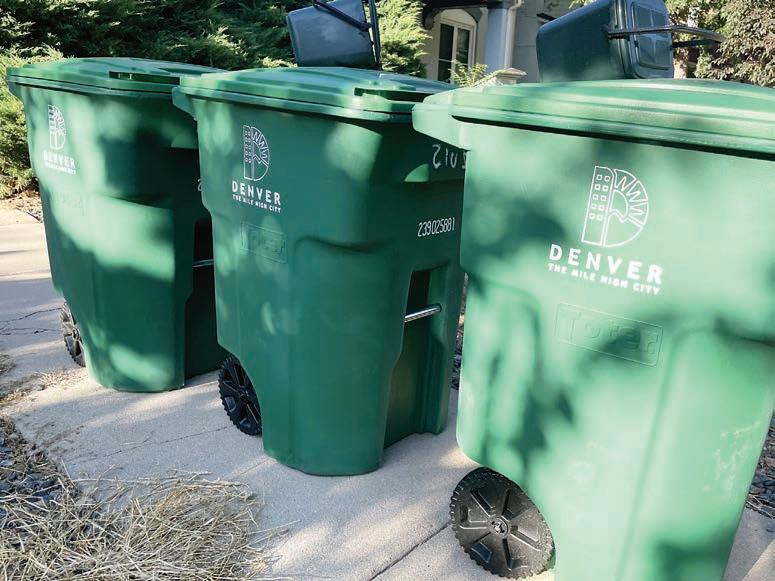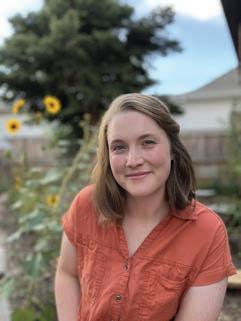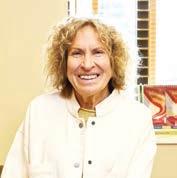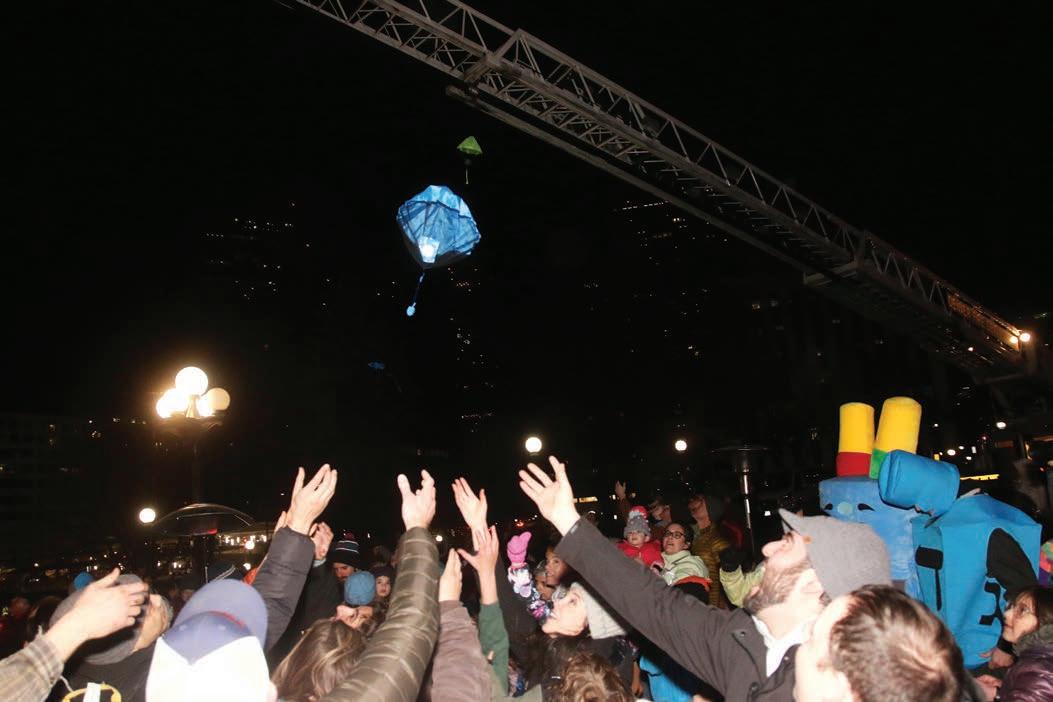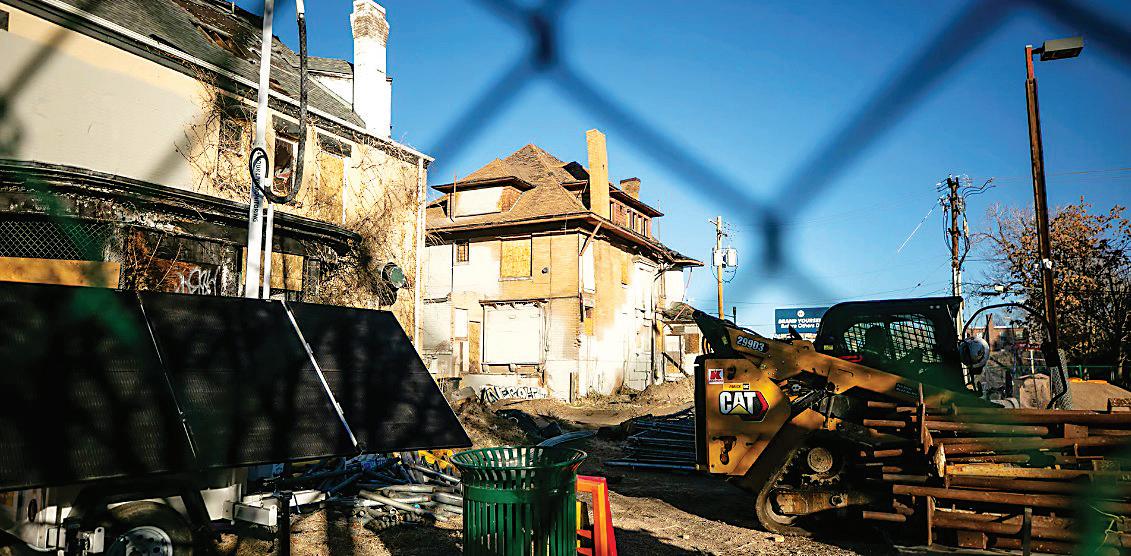BY
Less than a week after winning and accepting re-election this November, Denver state Sen. Chris Hansen announced he would vacate his seat.
His resignation announcement came just days after securing reelection, leaving a vacancy committee responsible for choosing his replacement, and hoisting any potential replacements into a game of political musical chairs. Hansen’s last day is Jan. 9. e timing of Hansen’s resignation has earned him some political sideeye from constituents, who are now unable to vote for his seat until 2028, as well as some of his fellow Democratic colleagues.
BY LONDON LYLE
SPECIAL TO COLORADO COMMUNITY MEDIA
A chant rang out through Riverside Church in Je erson Park during a December meeting as the Denver Classroom Teachers Association (DCTA) rallied to launch their bargaining campaign for the 2025 scal year.
“Who’s got the power? We’ve got the power! What kind of power? Union power!”
It’s been three years since the DCTA has last bargained with Denver Public Schools (DPS), and despite the evening’s snowy weather, supporters were more red up than ever before.
Educators, students, activists and community members donning bright red clothes to signal their support for the union lled nearly every seat in the auditorium of Riverside Church, demanding fair wages, more manageable workloads, smaller class sizes and equitable treatment for DPS employees.
DCTA President Rob Gould outlined the union’s priorities in simple terms.
“We’re here tonight because DCTA bargaining is starting in
2025, and we understand the importance of standing united for the schools our students deserve,” Gould said. “One job should be enough for our committed, dedicated educators who show up and give their all to support students every day.
“We shouldn’t have to walk out of the school building at the end of the strenuous day and hop into their car to drive for Uber, or put on an apron to work at the co ee shop,” he continued. “One job should be enough.”
e rally brought together educators from across the district who shared their personal struggles with underfunding, overwork and alleged discrimination.
“I’ve seen teachers being pushed out of this district, especially teachers of color,” said Brian Weaver, a sixth-grade math teacher and bargaining team member. “Equity for our students and retention for our educators are at the heart of this ght.”
Colorado Community Media has reached out to DPS for comment.
Valerie Henderson, an early childhood education teacher at Sandra Todd-Williams Acad-
emy and a bargaining team member, explained that the families and students that DPS serves experience systemic inequities due to socioeconomic, racial and political factors.
“ e Denver Green School absorbed 200 new-to-country students in just 18 months, while other schools maintained classes of just 22 students. is isn’t a coincidence. is is systemic racism in action,” she said.
Special education teacher Alicia Lerose described the burden of excessive workloads on those who work with students with complex IEP (Individualized Education Plans) or 504 learning plans; despite actually needing resources to spend more one-on-one time with her students who need specialized care. “I’m doing the job of at least three people. Crisis is at an all-time high,” she said.
Henderson pointed to the challenges of growing class sizes for educators working with students with disabilities.
“We’ve seen special education classrooms, which are supposed to be small by design, ballooning to sizes of 30 or more students,” she said.
Notably, the United Federation of Teachers recommends a sta ng ratio of no more than 12 or 15 students per teacher, depending on grade level, for special education classrooms.
Other educators echoed her concerns about large class sizes and limited resources.
“With 35 students per class, if I spend just 90 seconds with each student, that’s my entire class period,” said Michelle Horwitz, teacher and co-chair of the DCTA bargaining team.
“We cannot give our students what they need in this situation.”
Students themselves were in attendance, many of them there to support their fellow classmate and the rally’s only student speaker, Phoebe Davis, the senior class president at East High School. Davis highlighted the impact of teacher turnover on students like herself and her peers.
“When teachers leave, our students lose the mentors, trust, and champions who inspire them,” she said. “Call the board. Write Marrero. Show up at the rallies. Teachers cannot sustain this ght alone.”
While vacancy committees are put in place in case of situations like these, they are widely contended. Just four days after voters reelected him, Hansen signed a contract to become the CEO of La Plata Electric Association, a Durango-based utilities company. His predecessor reportedly earned $545,000 annually, which is roughly 13 times what Hansen makes as a legislator. Critics argue his move leaves constituents in the lurch, just as the legislative session is set to begin.
Colorado’s vacancy committee process is designed to ll legislative seats as soon as possible. e Colorado Democratic Party’s Senate District 31 vacancy committee, made up of 109 members, will meet on Jan. 7 to choose Hansen’s successor. Whoever is picked will serve the remainder of his term, which runs through 2028 .
e vacancy committee meeting will include a candidate forum where nominees will answer pre-submitted questions from the public. Only committee members can vote, and they must be present—proxies are not allowed.
Adding to all this is Hansen’s endorsement of state Representativeelect Sean Camacho of District 6 as his successor.
If Camacho is selected, then his newly won House seat will open up and require a quick replacement. is decision will also be left up to another vacancy committee.
Katie March, who lost to Camacho during the June primary, is Hansen’s top pick for the representative role.
Members of the Denver Classroom Teachers Association (DCTA) met Dec. 12 at Riverside Church in Je erson Park to discuss what they want in their collective bargaining agreement.
PHOTO BY LONDON LYLE
LONDON LYLE SPECIAL TO COLORADO COMMUNITY MEDIA
BY ALLEN COWGILL SPECIAL TO COLORADO COMMUNITY MEDIA
e Denver Department of Transportation and Infrastructure (DOTI) is accelerating its rollout of the citywide compost collection program. All Denver neighborhoods will start getting compost pickup by March.
To accelerate the rollout, DOTI is making a trade o , eliminating the weekly pickup of recycling. Denver residents will instead get recycling pickup every other week. Compost pickup will be weekly as will trash pickup.
Another change to make the accelerated compost rollout possible is largeitem pickup will only come once every nine weeks. DOTI’s goal is to divert 50% of all waste from the land ll by 2027. By the end of this process the department projects to have around 115,000 compost customers and 180,000 recycling and trash customers.
Denver residents who do not yet have compost service should have gotten a letter with more details on selecting their compost cart size. More details are available at: Denvergov.org/CompostRollout.
Compost carts can handle any kind of food waste including food scraps, egg shells and even bones. ey can also handle yard debris like weeds, grass clippings, leaves, and small tree branches. Denver no longer accepts paper products or products labeled as compostable such as cups or plates in compost bins as of April 2023, since the state’s largest compost processor stopped taking those items.
DOTI stated it was comfortable going back to recycling pickups every other week as weekly collection o ered in 2023 and 2024 has not yielded “a signi cant increase in recyclables collected, while trucks circled the city twice as often.” e department said residents should break down their cardboard boxes to maximize space in their compost bins. If people need extra space, DOTI will take requests for a second compost bin sometime starting in the second quarter of this year online or at 311. Residents are also reminded that plastic bags are not permitted in recycling bins.
Residents can see their own recycling
or large item pickup week online and can also download the smart phone app to see the schedule and get reminders at Denvergov.org/TrashSchedule.
At a Denver City Council Budget and Policy Committee meeting in November, DOTI presented an update on the program to the City Council. DOTI mentioned that the changes will allow the department to move their illegal dumping clean up team from eight hours a week to a full-time crew at 40 hours per week.
Councilman Kevin Flynn said it would be helpful if DOTI allows residents to have the option of the small compost bins because many residents in townhome communities don’t need the larger bins and often can’t t them in their garage.
DOTI indicated that is not an option as they have a low supply of the smaller bins, and they also have found that residents tend to overstu their bins, which is why the department is only o ering the larger compost bins.
Council President Amanda P. Sandoval, representative for North Denver, questioned why DOTI was dropping weekly recycling when the council members who sponsored the legislation to
e use of vacancy committees is far from a new phenomenon in Colorado politics.
move to volume-based trash pricing in 2022 had made it clear that the move to weekly recycling was very important.
“It feels ba ing to me that you all are coming back saying that you didn’t have it in the program to do weekly recycling,”
Sandoval said to DOTI leadership in the committee meeting.
Sandoval also expressed disappointment with the change to recycling every other week and also noted that her family has full recycling bins every week.
Councilman Paul Kashmann also noted it was very clear to him that weekly
e candidates jostling for Hansen’s Senate seat are from a variety of backgrounds. As it stands currently, there are eight of them:
• Sean Camacho Hansen’s endorsed successor and Representative-elect for Capitol Hill.
• Iris Halpern, a civil rights attorney and former union organizer.
• Chris Chiari, owner of the Patterson Inn and a former lm director.
• Matthew Ball, policy director for Denver Mayor Mike Johnston.
• Monica VanBuskirk, former chief policy o cer for Colorado’s health exchange.
• June Churchill, a bicycle lobbyist known as “Denver’s bike mayor.”
• Shaneis Malou , chief of sta at the Auraria Higher Education Center.
• Jaime Lewis, an RTD board member and disability rights advocate.
According to recent studies, approximately one-third of sitting Colorado legislators have been selected for a position by a vacancy committee at least once in their careers. Some of the same Centennial state’s current legislators who were appointed through this process, are now engaging in ongoing debates about its democratic legitimacy.
ose who favor special elections over vacancy committees say that the vacancy committee system allows party insiders to make decisions that should belong to the constituents they serve, while proponents of vacancy committees argue it’s a practical solution that avoids costly and time-consuming special elections.
Colorado’s 2025 lawmaking term starts on Jan. 6, followed by the meeting at 6:30 p.m. Jan. 7 at Christ Church United Methodist, 690 Colorado Blvd., where we will see who replaces Hansen. e rst
session of the year for the general assembly is Jan. 8.
recycling was part of the volume based trash program during the process to pass the legislation. Councilman Chris Hinds, also expressed frustration that DOTI did not have a stakeholder process around changing to biweekly recycling. In response to some of the comments, DOTI Director Amy Ford said research shows that while recycling is good from a reuse perspective, increasing compost is more bene cial from a greenhouse gas emissions perspective.
Compost bins from the city of Denver sit on a curb. COURTESY OF THE DENVER DEPARTMENT OF TRANSPORTATION & INFRASTRUCTURE
Zach Zevallos, a fire dancer, performs Jan. 1 for the Chanukah at the Capitol event, hosted by Jewish in the City, where hundreds of people attended. PHOTO BY ERIC HEINZ Story on Page 8.
BY ERNEST GURULÉ SPECIAL TO COLORADO COMMUNITY MEDIA
With a new presidential administration soon to take the reins of the government, health experts are especially worried about the man set to become the country’s next Secretary of Health and Human Services and the movement he supports.
e concern is based on the long antivaccination history of nominee Robert F. Kennedy, Jr. Kennedy has falsely and repeatedly linked vaccines to autism, basing his claim on a discredited 1998 article published in the British medical journal, e Lancet.
e 1998 article linking the MMR (measles, mumps, rubella) vaccine to autism was almost immediately refuted but not before launching the rst major anti-vaccine movement. e article resulted in almost immediate collateral damage with an outbreak of more than 12,000 cases of measles and at least three deaths in Great Britain in the months following its publication.
e idea that a war on vaccines could once again erupt is causing great concern in the medical community, including in Denver.
“I think we’ve seen in the U.S. and the world when vaccine con dence falls, we start to see disease again,” said Dr. Josh Williams, a Denver Health and Hospitals pediatrician.
In interviewing Dr. Williams, he made clear he was not responding to the Department of Health and Human Services nominee’s history of vaccine denial but answering only as an expert and proponent of vaccines.
In a world where a virus can hopscotch an entire ocean in hours, a virus can plant itself on a new continent in a single day and grow exponentially in a matter of weeks.
“ e diseases that our grandparents and parents saw,” Williams said, “are only a ight away. If our levels of immunity are not high enough, we will see these diseases.”
e polio vaccine was approved April 12, 1955. It was administered the following day at the Mayo Clinic. Today it is credited with all but wiping out polio in the western hemisphere.
While Dr. Jonas Salk’s polio vaccine remains one of the 20th century’s most renowned and reliable vaccines, there are others that have also performed in the
same exemplary way.
Vaccines for 14 diseases, including diphtheria, hepatitis B, measles, meningitis A and yellow fever, according to the World Health Organization, have reduced infant deaths by 40% globally and by 50% in Africa. ey are also credited with saving as many as 154 million lives worldwide over the last fty years, including more than 100 million infants.
BY COLORADO COMMUNITY MEDIA STAFF
e Denver City Council recently passed a measure to allow accessory dwelling units (ADUs) in all residential zoning areas of the city.
e citywide ADUs measure was sponsored by Councilmembers Sarah Parady, Chris Hinds and Darrell Watson, in partnership with Mayor Mike Johnston and the Department of Community Planning and Development (CPD).
“In every corner of our city, the cost of housing is top of mind for Denverites, and simple improvements to our policies like this make a real di erence for working families,” Johnston stated. “As we continue to push to create thousands of units of a ordable housing, giving residents the option to build an ADU will not only make it easier for families to stay in Denver long-term, but will put us one step closer to tackling the challenge of housing a ordability.”
In a seven-year period ending in 1955, polio changed our lives. Fairs and sporting events were cancelled, swimming pools and movie theaters were closed; the threat of polio was both frightening and omnipresent.
In 1952 there were more than 58,000 cases reported resulting in 3,200 deaths. Many survived the disease but were paralyzed for the remainder of their lives.
e iron lung, a metal tube used for helping victims breathe because their lungs had become paralyzed, became the symbol of the disease. Other symbols were leg braces and wheelchairs, most often worn or occupied by polio’s surviving victims.
While a ban on the polio vaccine grabs most of the attention, Williams said, vaccines for ghting things as predictable as in uenza may also be put under the same
cloud of suspicion in a new administration. e CDC has recently documented a spike in whooping cough, including a single case in Colorado. A vaccine, including a booster every ten years, is recommended for diphtheria, tetanus and pertussis (DPT). Pertussis is informally called whooping cough.
Williams said the polio scare came home for him when his grandmother shared his own father’s polio vaccine cards with him. “ ey knew it (polio) was possible,” he said. “ eir home,” not unlike thousands in every state, “went under quarantine.”
President-elect Donald Trump has said that he will make certain that the polio vaccine remains available. But Kennedy’s words, most especially his belief that vaccines have “killed many, many, many, many, many more people than polio ever did,” provide less than full con dence to public health o cials.
Accessory dwelling units are self-contained, smaller living spaces with their own kitchen, bath and sleeping area that are an extension of an existing property, either attached or detached. ey are often called “mother-in-law suites,” “granny ats,” “casitas,” “backyard cottages,” “garage apartments” or “basement apartments.” e measure allows ADUs on 70% of Denver’s land, compared to 36% before the new zoning rules were passed, which
went into e ect Dec. 16. e measure also implemented state legislation that requires Denver to allow accessory dwelling units in all residential districts, overriding rules by homeowner associations that prevent them and requires updates to Denver’s owner occupancy requirement for single-unit zone districts. Prior to passage of this measure, requirements dictated that if an owner
SEE DWELLINGS, P5
Vials of RSV, COVID-19 and the flu virus vaccines. SHUTTERSTOCK
BY MERYL PHAIR
SPECIAL TO COLORADO COMMUNITY MEDIA
Devin Jamroz knows there is something special about the white wheat variety known as India Jammu that is grown in Colorado.
e CEO of the company Dry Storage in Boulder said the grain made its way to the front range after being pulled from a seed vault in 2020 and passed into the hands of local baker Andy Clark at Moxie Bread Co. in Louisville.
Clark milled some but got so excited over the bread it produced that he handed it o to the MASA Seed Foundation in Boulder where it wound up with several local farmers and eventually to Dry Storage as they were putting together their inventory of local grains.
“We launched it (Indian Jammu) a month ago and we’re getting it into more chefs and baker’s hands to play with,” Jamoz said. “It could potentially change the game and change the narrative around the usability of single-varietal, stone-milled ours because it is just so easy to use.”
While Colorado is known to grow highprotein winter wheat due to the temperature uctuation and a relatively short growing season, Jamroz said more than 80% of the wheat grown in the state is shipped elsewhere.
Local grains can be expensive compared to commodity our and more challenging to work with due to their unique characteristics, but the appeal of local sourcing along with heightened nutrition and taste has been bringing regional our back to Denver’s food scene.
Launched with a mission of bringing local grains back into the supply chain, James Beard Award-nominated chef Kelly Whitaker and Id Est Hospitality founded Dry Storage in 2019 to create a product they were struggling to nd in the local market.
Following a successful trial with six local farms in the San Luis Valley, Dry Storage has partnered with local farms using regenerative and organic practices, milling their wheat and distributing the four to a growing number of regional partners, along with operating a cafe, grain mill and bakery based in Boulder.
Similarly to many mass-produced staples such as co ee, modern mills can produce large quantities of commodity our with a consistent avor pro le, enabling identical products to be created anywhere. Stone mills like the one used by Dry Storage don’t strip away as many nutrients, maintaining the grain’s unique avor pro le.
“ ere’s an undeniable taste of Colorado,” Jamroz said. “You can tell the
DWELLINGS
didn’t live on the property, the ADU was not allowed to be used. e new rules allow an ADU to be used even if the owner later moved o the property. “By streamlining the ADU process, we’re removing barriers that have made
di erence between wheat that’s been grown here and grown elsewhere.”
Rebel Bread on South Broadway has had the unique experience of transitioning its beloved neighborhood baked goods to new recipes derived entirely from local grains. Since beginning to work with Dry Storage in 2023, the small-batch, artisan bakery initially introduced the Sonoran sandwich loaf from a variety of Colorado rye our and has incorporated it into their popular favorites such as the charcuterie sourdough, kimchi squash and cheddar sourdough and e Nonna G sourdough.
“After operating the bakery for a few years, we learned how important our sourcing could be, both for the nutrition of the product as well as for the role that we then play in local economies and sustainable agriculture,” said Zach Martinucci, founder and baker at Rebel Bread.
As a baker, Martinucci said working with a single variety of our produced from a local mill makes for a more intentional process all around as the bakery has to pay closer attention to the nuances in the our.
“We have to pay attention to hydration, the amount of water we’re adding, and our fermentation reactions are more active. ey happen more quickly,” Martinucci said. “ e depth of avor is incredible and the product tastes fresher. It tastes like we baked it earlier.”
Perfecting the new recipe was an undertaking as Rebel Bread sought to come up with a nished product that tasted the same if not better than their original loaves. Despite the challenge a transition to local grains can present for existing businesses, Martinucci said he’s been excited to see more businesses in the Denver metro area like Odell’s Bagels embracing local grains from day one.
e use of local grains not only aligned with Odell’s philosophy as a chef, but he said it enabled the shop to deliver a delicious locally derived product with a unique taste.
Serving Denver’s Highlands neighborhood out of the old Denver Bread Company building on Irving Street, Odell’s Bagel has embraced the use of locally sourced grains along with other ingredients since opening its doors in October.
“I have always strived to use local ingredients and when we opened this place, that was not going to change,” chef Miles Odell said. “It’s nice to know where our grains are coming from and that our farmers are being supported. It’s a small ecosystem that is sustainable.”
Since launching the bagel shop, Odell’s has been whipping up an assortment of hand-rolled and naturally fermented bagels. Along with the use of local grains, the shop focuses on incorporating as many locally sourced ingredients as possible such as seasonal jams, currently o ering a plum jam and will soon be moving into marmalades for the winter citrus season.
it challenging for homeowners to improve their properties and strengthen our communities,” Hinds said. “ is policy change would eliminate navigating Denver’s complex zoning code to build an ADU, and the city will save valuable time by eliminating the need for lengthy rezoning processes. is change not only simpli es the permitting process but also accelerates the timeline for residents to build what they
“It’s impossible to replicate the avor we’re going after if we’re not using these gains,” Odell said. “ is is not an East Coast bagel. We made the recipe and we baked them here. It’s a Denver-style bagel.” e enthusiasm for a more local taste has been working its way onto the heart of Denver, fueling the over 100 restaurants including six Michelin Star restaurants that use Dry Storage’s grain along with bakeries, pizza shops, breweries and distilleries.
New Image Brewing in Arvada is currently experimenting with local wheat for their core beer recipes while a scratch kitchen at the Empower Field is che ng up pancakes sourced from local wheats for the Denver Broncos.
Because locally sourced wheat can come at a higher price than commodity our, Jamroz said accessibility is an integral aspect of their operations. ey are
need, ultimately making Denver a more livable, accessible city for everyone.”
e ADU measure also followed the city’s plan of updating building standards for ADUs to make them better t in di erent neighborhoods.
A report from the Joint Center for Housing Studies of Harvard University found that ADUs “have the potential to address a variety of housing-related challenges like a ordability, equity,
currently working on a pilot program with the Cherry Creek School District to provide a monthly cinnamon roll breakfast with whole wheat our made especially for the schools, receiving positive feedback from students.
With more businesses experimenting with local wheat, this year the mill saw its rst renovations since opening, but Jamroz said moving forward Dry Storage will have to be creative about how they scale to stay true to their local-focused mission.
He emphasized that Dry Storage’s mission statement of “grain is our medium for change” is much bigger than the mill’s operations in Colorado but indicative of an alternative method of food production that values local products and producers. “ e idea would be to start opening new facilities in di erent regions that are big enough to produce a competitively priced our but each being region speci c and working with a network of local farmers,” Jamroz said. “We’re leaning into local grain economies and the unique wheat that can be grown in di erent places around the country.”
and environmental issues. Moreover, because ADUs generally are small in ll units, they can achieve these gains without signi cantly altering the character of existing residential neighborhoods.”
ADUs can serve as a separate space where elderly parents or kids living at home can still have independence, a space that can be rented out to generate income, or just to rent a smaller, more affordable space.
An artisan design on a product of Rebel Bread, which has been using Colorado-grown grains since at least last year. COURTESY OF EB PIX
A publication of
Mailing Address:
750 W. Hampden Ave., Suite 225
Englewood, CO 80110
Phone: 303-566-4100
To subscribe call 303-566-4100 or Scan this QR Code
BROOKE WARNER
Executive Director brooke@ntln.org
LINDA SHAPLEY
Director of Editorial & Audience lshapley@coloradocommunitymedia.com
ERIC HEINZ Editor eric@cotln.org
LINDSAY NICOLETTI
Operations/ Circulation Manager lnicoletti@coloradocommunitymedia.com
ERIN ADDENBROOKE Marketing Consultant eaddenbrooke@coloradocommunitymedia.com
ERIN FRANKS Production Manager efranks@coloradocommunitymedia.com
BUSINESS INQUIRIES
For advertiser or vendor questions, please email our business department at accounting@ coloradocommunitymedia.com
Columnists & Guest Commentaries
Columnist opinions are not necessarily those of Life on Cap Hill.
We welcome letters to the editor. Please include your full name, address and the best number to reach you by telephone. Email letters to eric@cotln.org
Deadline
5 p.m. on the 20th of each month for the following month’s paper.
Ah, the new year. at magical time when the calendar resets, the leftover holiday cookies mysteriously vanish, and we tell ourselves, “ is is the year I get my life together!” Fast-forward a few weeks, and we’re panic-Googling how to organize the junk drawer while eating snacks for dinner. Sound familiar?
Here’s the deal: resolutions tend to crash and burn because they’re too extreme. Instead of aiming for perfection, focus on goals—realistic ones that simplify your life, create balance and are actually doable for you and your family. Let’s dive into some practical, fun tips to kick o the new year with less stress and more joy.
For the adults: manageable goals that actually work
1. Embrace the power of “no”
Let’s start with this gem: you can’t do it all. Say “no” to that one extra meeting, bake sale, or event that will push you over the edge.
Goal: Say “no” to one obligation each week and enjoy the freedom. Practice in the mirror if necessary—“No, but thanks for asking!”
2. Make a “not-to-do” list
To-do lists are great, but what about the things that waste your time and energy? Doom-scrolling, reorganizing your fridge for the 15th time, or overthinking that a “Let’s get lunch!” text can all go on the not-to-do list.
Goal: Identify one time-sucking habit and
They say not to judge a book by its cover, but when I saw “ e Last Gifts of the Universe” by Riley August, I absolutely judged.
When I see a book that has a cat in an astronaut suit on the cover, I’m going to pick it up. Luckily for me, this cozy science- ction novel was perfect reading for such a busy time of year.
CORRECTIONS
In the December edition of Life on Capitol Hill on page 2 in the story “DPS votes to finalize closure of seven schools,” the address of West Middle School was incorrect. The address is 951 Elati St.
Colorado Trust for Local News asks readers to make us aware of mistakes we may have made.
Email linda@cotln.org if you notice a possible error you would like us to take a look at.
“ e Last Gifts of the Universe” follows the story of a pair of siblings, Scout and Kieran, and their adorable adventuring companion, Pumpkin the cat. Scout is a space archivist (my dream job if I lived 700 years in the future) traveling to di erent worlds searching for information about other alien races that have seemingly been destroyed by some mysterious creature.
All life on these planets is gone— people, ora, fauna, even bacteria. Scout and Kieran (with Pumpkin always in tow!) are searching for data caches to gather information about what happened to send back to their home world.
ey aren’t the only ones looking for answers though, and soon readers are taken on a fast-paced, emotional journey through space as Scout and Kieran race to nd the caches rst.
ough this novel is short, it packs a punch. e writing is sharp with great world-building. e characters are well-developed, full of life and emotion, and the story is fun!
LIFE BALANCED
cut it out (or down). Pro-tip: hand that o to TULA.
For the Kids: Fun Goals They’ll Actually Stick With
1. Learn one new skill
Megan Trask and Cody Galloway
3. Schedule “me time” like a dentist appointment
If you can keep a dentist appointment, you can carve out 15 to 30 minutes just for yourself. Whether it’s reading, meditating, or zoning out with a cup of tea, make it non-negotiable.
Goal: Schedule weekly “me time” on your calendar. Protect it ercely.
4. Tackle one chaos zone
Every house has that one thing. e junk drawer, the Tupperware cabinet, or the laundry chair (we see you). Choose one area to declutter and breathe a sigh of relief every time you look at it.
Goal: Start small. One drawer or one shelf— baby steps!
5. make exercise fun (no gym required)
Skip the boring treadmill. Dance in your kitchen, join a local pickleball league, or take a walk while listening to your favorite podcast. Moving your body doesn’t have to feel like a chore.
Goal: Find one fun way to move three times a week for 20 minutes.
It’s not all lighthearted though. e siblings are processing their own grief from the loss of their mother. e data caches they collect prove to be full of heartbreak as alien races confront the existential weight of their inevitable mortality. At one point I found myself overcome by the pangs of grief and the beauty of life and as Kieran and Scout uncovered another account of a lost alien species, blubbering for my partner to go get the tissues.
“ e Last Gifts of the Universe” felt like a warm hug, and it is a great option both for readers who already love science ction and for those who are interested but a little intimidated by the genre. e dynamics between characters and the mystery of what happened to the universe will grab readers’ attention from the start. If you’re looking for a cozy read this January, you might give this one a try!
“ e Last Gifts of the Universe” can be found at your closest Denver Public Library location or as an eBook at denverlibrary.org. Already read it? Check out these readalikes: “A Psalm for the Wild-Built” by Becky Chambers, “A Half-built Garden” by Ruthanna Emrys or “Chilling E ect” by Valerie Valdes.
Kids thrive on challenges. Whether it’s tying shoes faster, learning a new recipe, or mastering their favorite trick shot, give them a fun goal they can work toward. Kid Goal: “I’m going to learn how to [ ll in the blank] this year!” Keep it simple and praise progress.
2. Start a “Kindness Jar”
Encourage kids to jot down one kind thing they do each week and add it to a jar. At the end of the year, they’ll see all the good they’ve done (and you’ll enjoy a few sibling cease res along the way).
Kid Goal: Do one small kind act weekly, like sharing a toy or helping around the house.
3. Get Outside Daily
Fresh air is the ultimate boredom buster. Bundle up for a nature walk, build snow forts, or just let the kids run wild in the backyard.
Kid Goal: Spend 20 minutes outside every day (even if it’s just to yell, “it’s freezing!” and come back in).
4. Organize one thing they love
Whether it’s their toys, art supplies, or beloved Lego stash, let kids take charge of organizing something they care about. Kid Goal: Keep one area tidy. Even if it’s tiny, it’s progress!
5. Make a “no-screen fun list”
SEE BALANCED, P7
e 10th annual Winter of Reading has arrived at the Denver Public Library! Grab a game board at any of our locations and play along to win a prize, a mug or a tote, while supplies last. Find more information at denverlibrary.org/winterofreading.
Ashley Love is a librarian at Denver Public Library’s Central branch. She spends her free time gardening, hiking, and reading long fantasy books.
Urology and gynecology often work together, this is how the eld of urogynecology evolved. e doctor’s focus is on the urinary tract and the female reproductive systems in tandem.
ere is potential overlap in these systems and conditions with the female urinary system and reproductive organs being closely situated in the body. e Mayo Clinic cites that urinary incontinence and involuntary leakage are common symptoms that a ect 50% of adult women. Around 50-60% of women will experience a urinary tract infection (UTI) in their lifetime. ese percentages show the importance of having specialized urogynecologists dedicated to restoring the normal function and autonomy to help women regain their con dence.
A urogynecologist can diagnose and treat many disorders in women such as pelvic oor dysfunction. e pelvic oor has muscles, ligaments and con-
WOMEN’S WELLNESS
Dr. Terry Dunn
nective tissues all supporting organs in the pelvis. ese organs are the bladder, vagina, uterus and rectum that are responsible for basic bodily functions like urination and bowel movements. e organs located in the pelvis are key indicators of a healthy female reproductive system.
Urology diagnoses and treats conditions relating to the urinary tract that can include pelvic oor disorders, urinary tract infections (UTIs), infertility, incontinence and pelvic oor prolapse. A urologist is specialized to deal with complex urinary tract problems in both women and men such as an overactive bladder or blood in the urine (hematuria).
Gynecology focuses on the repro-
ductive organs with services for specialized care for women’s reproductive needs. Beyond pregnancy this can include menopause, hormonal problems, menstruation and contraceptives. Specializing in women’s reproductive health, gynecologists conduct pap smears, pelvic exams and cancer screening procedures. Some gynecologists are also obstetricians (OBGYNs) that additionally specialize in pregnancy and childbirth.
Urogynecology o ers a full spectrum of women’s health care assessments from breast and pelvic exam preventive care to urinary incontinence and pelvic oor disorders. It brings everything urology and gynecology have to the table to e ectively diagnose and treat a variety of conditions.
Dr. Terry Dunn is the owner of Foothills Urogynecology, a Denver-based practice specializing in women’s health. To learn more, visit www.urogyns.com.
Screens are great, but too much can lead to meltdowns (for everyone). Help kids brainstorm screen-free activities, like building with Legos, playing board games, or crafting something cool.
Kid Goal: Do one “no-screen” activity every day.
Balance, not perfection e key to starting the new year right isn’t about perfection. It’s about setting realistic goals that reduce stress and create balance for the whole family. e beauty of goals (unlike resolutions) is that they’re exible and achievable.
So, skip the “New Year, New Me” pressure. Tackle one small thing at a time, make space for what matters, and remember to have a little fun along the way. And if all else fails? ere’s always co ee, humor, and a whole year to get it (mostly) right.
You’ve got this!
Megan Trask and Cody Galloway are Denver residents and co-founders ofTULA Life Balanced. Learn more about their business at tulabalanced.com.
BY PHOTOS AND TEXT BY ERIC HEINZ
ere were balloon artists, local government o cials, mascots in Chanukah-themed out ts, an
and a re spectacle at the New Year’s Day celebration Chanukah at the Capitol, hosted by Jewish in the City. Hundreds of people came to the celebration that included the lighting of the last candle of the Chanukah holiday.
Denver Fire Department drops dreidels for attendees Jan. 1 at the Chanukah at the Capitol event, hosted by Jewish in the City.
Denver Mayor Mike Johnston lights the menorah Jan. 1 at the Chanukah at the Capitol ceremonies, hosted by Jewish in the City.
Balloons for children were made Jan. 1 during the Chanukah at the Capitol festivities, hosted by Jewish in the City.
BY ANDREW KENNY DENVERITE
Vines and gra ti spread across brick walls. e windows are boarded up, and a few are missing altogether. Sunlight beams through a re-scorched roof. ese two mansions have stood on East Colfax Avenue for a century, and it shows.
But after years of debate, their end is coming soon.
On Tuesday, a developer got permission to tear down the dilapidated old mansions at the corner of Franklin Street and Colfax Avenue — part of the city’s Wyman Historic District. Current owner Pando Holdings successfully argued that renovating the buildings would be too costly, especially after a re earlier this year.
“ e issue fundamentally, is it will cost more to rehabilitate the building than the resulting building will be worth,” said Bill Kyriagis, a representative for the owners, at a meeting of the city’s Landmark Preservation Commission.
e commission ultimately agreed to allow demolition. It was the latest ght over how far Denver should go to preserve historic buildings.
“It hurts to make this decision to allow the demolition. But I don’t feel like we have a choice, given the way that the statute’s written,” commission member Nick Foussianes said.
A tale of two mansions
When the mansions were built in the late 1800s, they were part of an attractive new neighborhood along Colfax’s cable car route.
ey were among the last single-family homes built on this stretch of Colfax, and they eventually were converted to commercial uses themselves. One was previously home to Bourbon Chicken, which gave a savory smell to the block.
Pando Holdings bought the buildings in 2017.
e developer previously planned for “complete restoration and preservation” alongside construction of a new apartment building nearby. But that project was delayed by rising construction costs during the pandemic.. is March, a re severely damaged one of the old houses. e city soon declared 1600 E. Colfax Ave. to be unsafe.
Later, Pando proposed a total demolition of both buildings.
e buildings are designated as landmarks, meaning demolition and other changes can’t happen without approval from the city’s landmark commission.
e commission denied an earlier request, but the owner asked again, saying that rehabilitating the buildings would be an economic hardship.
What makes preservation ‘worth it’?
Rehabilitation of the two buildings would cost nearly $8 million, accord-
ing to estimates from outside groups. But all that spending would result in very littlenancial bene t to the value of the property, the developer argued.
“It is an unconstitutional regulatory taking to impose a regulation that denies all economically bene cial use of a property without compensating the property owner,” Kyriagis said.
At the hearing, local architect David Wise urged the city to preserve the buildings. He said that preservation is dicult but worthwhile.
“I just believe it’s worth ghting for. I believe it will be a loss felt on a daily basis for many of us who really feel Colfax may nally be on its way back up,” Wise said.
“ e investments that we are sometimes forced to make reinforce the neighborhood, the character of it, but also the value of it,” agreed Cameron Bertron, who lives in the district.
Historic Denver also asked for the city to deny the demolition request, arguing that tax credits could help defray the heavy construction costs.
But another neighbor, Bethany Gravell, said that the ruined buildings were ruining the neighborhood.
“If economic hardship is denied and these buildings remain vacant, the neighborhoods along Colfax will be harmed,” she said.
“It’s a true conundrum. is is really the de nition, right?” said Rusty Brown, a commission member who ultimately supported demolition.
Only one member of the commission, George Dennis, voted to deny the demolition request
“ at wasn’t fun,” Chair Julie Johnson said after the vote.
The old Bourbon Chicken building at Franklin Street and Colfax Avenue. Dec. 6, 2024. PHOTO BY KEVIN BEATY/DENVERITE
BY ERNEST GURULÉ
Paychecks for Denver minimum wage workers are set to get a little fatter in the new year, thanks to the Denver City Auditor.
In 2025, Denver’s minimum wage will rise to $18.81 an hour from the current $18.29 rate, a boost of 52 cents an hour.
“All workers performing a job within the City and County of Denver“are entitled to the city’s minimum wage,” said Michael Brannen, executive director of communications and government relations for the Denver Auditor’s o ce. e only exception, he said, are workers whose pay is supplemented with tips. For example, if an employer can prove a food server earns at least $3.02 an hour in tips, they would qualify for only $15.79 per hour, Brannen said. e two gures would equal the city’s $18.81 rate. In 2019, the State Legislature authorized municipalities to set their own minimum wage. Denver City Council then created its own minimum wage table and set starting pay at $12.85 per hour. Since then, pay for minimum wage
workers has increased by nearly fty percent to $18.81, 2025’s new hourly rate.
“I know people who work full-time, and it means a lot to them,” Li Li Ross said.
For Ross, who works part-time at an o -north Tennyson Street restaurant, the job ends when she returns to Omaha and Creighton University where she attends college. Still, she said of the pay boost, “it’s something.”
Across town on Gaylord Street, sidewalks are crowded two days after Christmas. On one corner, people are lulling outside the Washington Park Grille waiting for a table; at the other end, people are just strolling into the Devil’s Food Bakery.
On this day when the holiday is now a memory, it’s doubtful customers are even thinking about Denver’s new year’s pay scale or, perhaps, don’t even know. But store owners certainly do.
“I’m all for it,” said one business owner who asked his name not be used. “People have to live, pay rent, buy food,” he says before waxing nostalgically about an era when “people could actually a ord a home on a single paycheck.”
Of course, unlike his neighbors who will be paying the new wage, he has no sta .
But for business owners who do have hired help, the city’s 2025 wage scale is not making for a happy new year. Paying workers more—an estimated 45,000 workers—it’s going to be costly. And the cost will be passed on to consumers.
e 45,000 gure, said Brannen, comes from a Rutgers University study commissioned by the Auditor’s O ce. e study said at least that many workers in Denver were paid below the minimum wage in Denver between 2020 and 2024. at number of workers, Brannen said “has increased signi cantly since 2020.”
To that end, the Denver Auditor’s O ce has gone after employers who underpaid workers and has collected more than $2 million illegally withheld from them in the last year. e gure—a record amount—is double what the auditor collected in unpaid wages just a year earlier. All of the recovered money, the auditor said, will go back to an estimated 3,500 people.
“Every case is important,” City Auditor Timothy O’Brien said in a news release. His o ce’s work in targeting employers, he said, “is a national example of how to do this work the right way—by engaging both workers and businesses in pursuit
of shared positive outcomes.”
One target of O’Brien’s o ce has been city strip clubs, some of which he said were misclassifying performers as nonemployees to skirt paying the legal minimum wage along with overtime.
But perhaps the o ce’s biggest catch was the nonpro t Urban Peak, a youth homeless shelter. Because Urban Peak used more than $2,000 in public funds, it was required to pay the city’s set wage scale. Urban Peak received more than $16 million from the city as part of its upgrade. e auditor’s o ce said the project was classi ed as “residential” rather than a “business” upgrade thus allowing workers to be paid less. Because of the misidenti cation, some workers were paid at a rate as much as 40% lower than they should have been.
Urban Peak was cited, O’Brien’s o ce said, because it used more than $2,000 in city funds. In fact, the city committed more than $16 million for the shelter upgrade.
Urban Peak contends the pay error was not intentional. It said the mistake was caused by a miscommunication between two Denver agencies.
BY MERYL PHAIR
SPECIAL TO COLORADO COMMUNITY MEDIA
Two dedicated booksellers with Hermitage Antiquarian Books had their lives upended by a violent home invasion on the evening of Dec. 1, which left Overland resident Joanne Weiss, 73, with multiple gunshot wounds.
e incident at Weiss’s home near West Jewell Avenue and East Elati Street left the community member paralyzed from the sternum down, placing her in critical care where she is still recovering with her partner Denie “Helene” Orr by her side.
“Despite the enormity of this life-altering event, Joanne and Denie are facing the future with incredible courage, resilience, and determination but the road ahead is long and lled with challenges, and they need our support more than ever,” wrote Hermitage Books manager Sam Butler on the GoFundMe page, which popped up soon after the incident.
Created by colleagues of Weiss at Hermitage Books, the fundraiser sought to raise $50,000 to help cover essentials, such as medical expenses not covered by insurance, rehabilitation and physical therapy, home modi cations for accessibility, mobility equipment and everyday living expenses.
“As Joanne and Denie move forward, they will have to make signi cant adjustments to their way of life, and the costs can be overwhelming,” Butler wrote. “We want to ease their burden so they can focus on recovering, supporting one another, and adapting to their new way of life.”
Since launching, the fundraiser has garnered support from community members, friends, family and people whose lives have touched the Hermitage and Weiss in a myriad of ways. Surpassing the initial goal in just over 50 hours, the amount was set to $75,000, which was surpassed yet
again and is currently at $77,474.
In addition to working for one of Denver’s oldest independent bookstores at 290 Fillmore St. for the past 30 years, Weiss and Orr are active members of Denver’s Overland community. Orr, who has served as president for the Neighbors of Overland North, was an outspoken advocate in ghting the Environmental Protection Agency and the S.W. Shattuck Company when hazardous waste was slated to be deposited near the area in 2018 and both booksellers spoke at Denver City Council meetings opposing plans for the Grandoozy Music Festival.
“Joanne and Denie have spent their lives enriching the lives of others –through their work, their kindness, and their dedication to their neighborhood and the broader bookselling community,” Butler wrote. “Your generosity and kindness can help turn this heartbreaking chapter into one of resilience, hope, and love.”
A link to the GofundMe can be found at gofundme.com/f/rally-for-joanne-acommunitys-call.
Joanne Weiss recovers after home invasion. COURTESY OF SAM BUTLER ON GOFUNDME
BY ERIC HEINZ
e area colloquially known as “South Broadway” has gone through many transformations over the years, yet it continues to be able to o er that speci c liveliness that Denver wouldn’t be the same without. at’s where the Broadway Merchants Association (BMA) and its supporters come in.
People on behalf of the BMA recently led an application with the city of Denver to create a 1.7-mile corridor that would be a business improvement district (BID), which would have businesses in the area pay into a fund that would establish more security presence, make improvements and help with promotions. Only properties within the BID would be subjected to the costs.
More than 260 businesses and 176 commercial properties would be included in the BID, if it is approved by the city.
e district would impose a mill, the amount of which will be determined later, among the businesses based on their assessed value and in return the businesses would get more security, money for maintenance, marketing and advertising, as well as operational funding. e mill submitted to the city was at 21, or $21 for every $1,000 of the assessed property value.
e next step, coming in the next
couple months, is to petition the businesses on whether they’d like to establish a BID, and then that would initiate the city council process on whether to approve the special district. e BID proposal would need majority support. e BMA and proponents for the BID submitted a preliminary operating budget of just over $2 million to the council, but Luke Johnson, president of the BMA, said that number is expected to drop as the association continues to determine its needs.
“ e plan is to take this up again right after the rst of the year and try to deal with some di erent issues and resolve it,” said William Feinberg, vice president of the BMA. “We’re trying to be as transparent as possible and have as much input from the people that it affects as possible.”
From an open records request with the city, Colorado Community Media obtained the application and complementary information about the Broadway BID.
“It is common for any entity submitting a BID application to further revise their submitted documents before they are presented to city council for its consideration as a part of the creation ordinance process,” stated Josh Rosenblum, the communications specialist for the Denver Department of Finance. “ at is likely to be the case in this instance as well.”
Rosenblum said the petition, if all
goes according to plan, is likely to be submitted in the spring. A city council committee meeting could then take place April 30 with a following public hearing on May 19. ese dates are very likely subject to change, depending on when the petition is submitted.
Why a BID?
e BMA is a Registered Neighborhood Organization that oversees the operations of the current district. But the leadership of the organization said they wanted something more robust.
“ is is something that’s been discussed and worked on over the years and it grew out of the BMA and it’s volunteer and has very limited capacity in terms of what it can really do, and a lot of the merchants who are members felt if we had something that was more structured and organized, and had more money, we could do more to promote the bars and di erent businesses and that was the motivation,” said William Feinberg, vice president of the BMA. Public safety is one of the highest priorities for the Broadway Business Improvement Distict proposal, as it is slated to have the largest portion of the preliminary budget submitted by the BMA. Feinberg said there is a dearth of security in the corridor, except for businesses that pay for it on their own dime.








People cross the street at Broadway between 1st Avenue and Irvington Place. The Broadway Merchants Association recently submitted an application with the city of Denver to establish a business improvement district, spanning from 6th Avenue to Ohio Avenue.
PHOTO BY ERIC HEINZ










